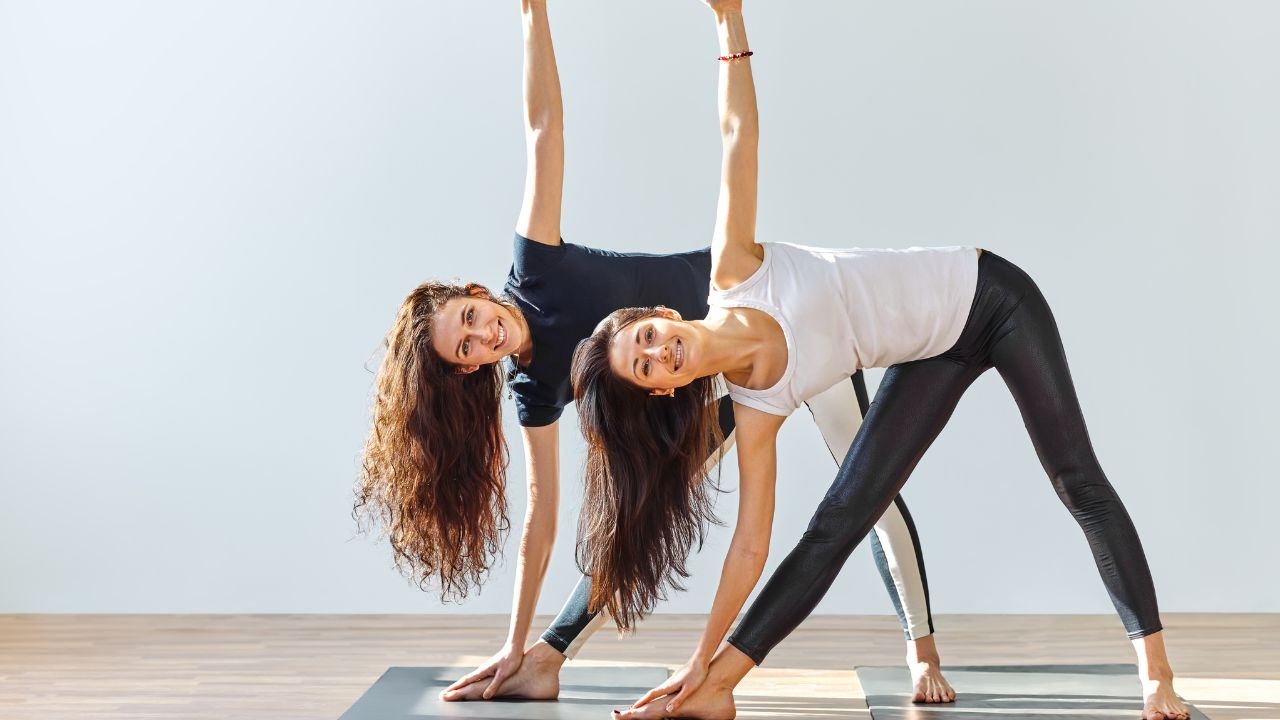Revolved Triangle Pose (Parivrtta Trikonasana)

Revolved Triangle Pose, or Parivrtta Trikonasana, is a standing twist pose that stretches the hamstrings, opens the chest, and strengthens the legs. It also improves balance and aids in digestion. Here’s how to practice Revolved Triangle Pose:
- Begin by standing at the top of your mat with your feet about hip-width apart. Step your left foot back, keeping it at a slight angle (around 45 degrees) and ensuring your right foot is pointing forward.
- Inhale and extend your arms out to the sides, reaching them parallel to the floor. Keep your palms facing down.
- Exhale and engage your core muscles. On the next inhale, lengthen your spine and reach forward with your torso, hinging at the hips. Extend your right hand down and place it on the mat, block, or your shin, on the outside of your right foot.
- As you inhale, extend your left arm toward the sky, opening your chest and twisting your upper body to the right. Keep your gaze directed upward or toward your raised hand.
- Maintain a firm connection between your left foot and the ground, keeping your leg engaged. Straighten your right leg as much as possible without locking the knee, and press the outer edge of your left foot into the mat.
- Maintain the length in your spine and avoid collapsing or rounding your back. If you find it difficult to reach the floor with your hand, you can use a block or place your hand on your shin for support.
- Breathe deeply and hold the pose for several breaths, feeling the twist and stretch along your spine, hamstrings, and chest.
- To release the pose, exhale and gently lower your raised hand back down to the mat. Inhale as you lift your torso and return to a standing position. Repeat the pose on the other side, stepping your right foot back and twisting to the left.
Some key points to remember while practicing Revolved Triangle Pose:
- Maintain a strong foundation through your legs and feet.
- Engage your core muscles to support your spine and maintain stability.
- Keep your chest open and your shoulders relaxed.
- Avoid collapsing or rounding your back. Focus on lengthening your spine.
- Modify the pose as needed by using a block or placing your hand on your shin for support.
Benefits of Revolved Triangle Pose include:
- Stretches the hamstrings, hips, and calves.
- Opens the chest, shoulders, and upper back.
- Increases spinal mobility and flexibility.
- Stimulates digestion and aids in detoxification.
- Improves balance, focus, and body awareness.
As with any yoga pose, listen to your body and practice with mindfulness. If you have any specific concerns or limitations, it’s advisable to consult with a qualified yoga teacher for guidance. Enjoy the energizing and twisting benefits of Revolved Triangle Pose.
Specific Content Keywords : parivrtta trikonasana benefits,revolved triangle pose parivrtta trikonasana steps,revolved triangle pose parivrtta trikonasana benefits,revolved triangle pose parivrtta trikonasana meaning,viparita trikonasana,parivrtta trikonasana contraindications,parivrtta trikonasana meaning,parivrtta trikonasana steps,revolved triangle pose (parivrtta trikonasana),revolved triangle pose benefits,difference between trikonasana and parivrtta trikonasana,difference between trikonasana and utthita trikonasana,how to pronounce parivrtta trikonasana,how to do parivrtta trikonasana.

